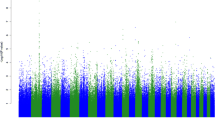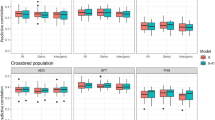Abstract
A total of 306 boars (108 Large White and 198 Landrace) were genotyped for 52 candidate SNPs to determine which of the polymorphisms influence growth rate, meat content and selection index. The effects of SNPs were estimated by a mixed linear model including a random additive polygenic animal effect, fixed effects of SNPs including additive, and pairwise additive-by-additive epistases, year*season of birth, breed and RYR1 genotype. In order to estimate all possible pairwise SNP combinations without overparameterising the model a stochastic approach was adopted. A total of 1 350 replications of the model were generated, each containing five randomly selected SNPs. The final estimates of the fixed effects of the model equaled an average out of the replications. The hypothesis of a nonzero effect of SNP was tested by the Wald test. Among 4 257 estimates calculated, many significant (P<0.01), but mostly minor effects (below 1 phenotypic standard deviation) were recorded. The selected SNPs will be further investigated to determine which may be used in MAS.
Similar content being viewed by others
References
Álvarez-Castro JM, Carlborg Ö, 2007. A unified model for functional and statistical epistasis and its application in quantitative trait loci analysis. Genetics 176: 1151–1167.
Amills M, Vidal O, Varona L, Tomas A, Gil M, Sanchez A, Noguera JL, 2005. Polymorphism of the pig 2,4-dienoyl CoA reductase 1 gene (DECR1) and its associations with carcass and meat quality traits. J Anim Sci 83: 493–498
Arnyasi M, Grindflek E, Jávor A, Lien S, 2006. Investigation of two candidate genes for meat quality traits in a quantitative trait locus region on SSC6: the porcine short heterodimer partner and heart fatty acid binding protein genes. J Anim Breed Genet 123: 198–203.
Brym P, Kamiński S, 2006. Database of SNPs in candidate genes potentially associated with yield and quality of pork. Anim Sci Pap Rep 24: 239–257.
Cockerham CC, 1954. An extension of the concept of partitioning hereditary variance for analysis of covariances among relatives when epistasis is present. Genetics 39: 859–882.
Fujii J, Otsu K, Zorzato F, de Leon S, Khanna S, Weiler VK, et al. 1991. Identification of a mutation in porcine ryanodine receptor associated with malignant hyperthermia. Science 253: 448–451.
Henderson CR, 1963. Statistical genetics and plant breeding. W. D. Hanson and H. F. Robinson, ed. Natl Acad Sci, National Research Council.
Houston RD, Haley CS, Archibald AL, Cameron ND, Plastow GS, Rance KA, 2006. A polymorphism in the 5’-untranslated region of the porcine cholecystokinin type a receptor gene affects feed intake and growth. Genetics 174: 1555–1563.
Jakubka R, Maak S, Kerziene S, Swalve HH, 2006. Associations of melanocortin 4 receptor (MC$R) polymorphism with performance traits in Lithuanian White pigs. J Anim Breed Genet 123: 17–22.
Kamiński S, Help H, Brym P, Ruść A, Wójcik E, 2008. SNiPORK — a microarray of SNPs in candidate genes potentially associated with pork yield and quality — development and validation in commercial breeds. Anim Biotechol 19: 1–27.
Kaminski S, Brym P, Wójcik E, 2009. A note on associations between polymorphism within 2,4-dienoyl-CoA reductase gene (DECR1) and growth rate in Polish Landrace boars. J Anim Feed Sci 18: 71–77.
Kao CH, Zeng ZB, 2002. Modelling epistasis of quantitative trait loci using Cockerham’s model. Genetics 160: 1243–1261.
Kim KS, Larsen N, Short T, Plastow G, Rothschild MF, 2000. A missense variant of the porcine melanocortin-4-receptor (MC4R) gene is associated with fatness, growth and feed intake traits. Mamm Genome 11: 131–135.
Kim KS, Lee JJ, Shin HY, Choi BH, Lee CK, Kim JJ, et al. 2006. Association of melanocortin 4 receptor (MC4R) and high mobility group AT-hook 1 (HMGA1) polymorphisms with pig growth and fat deposition traits. Anim Genet 37: 419–421.
Krzecio E, Kuryl J, Kocwin-Podsiadla M, Monin G, 2005. Associations of calpastatin (CAST/MspI) polymorphism with meat quality parameters of fatteners and its interaction with RYR1 genotypes. J Anim Breed Genet 4: 251–258.
Lei MG, Xiong YZ, Deng CY, Wu ZF, Harbitz I, Zuo B, Dai LH, 2004. Sequence variation in the porcine lipoprotein lipase gene. Anim Genet 35: 422–423.
Lin Z, Lou Y, Squires EJ, 2006. Functional polymorphism in porcine CYP2E1 gene: Its association with skatole levels. J Steroid Biochem Mol Biol 99: 231–237.
Lobjois V, Liaubet L, SanCristobal M, Glénisson J, Fève K, Rallières J, et al. 2008. A muscle transcriptome analysis identifies positional candidate genes for a complex trait in pig. Anim Genet 39: 147–162.
Meidtner K, Wermter AK, Hinney A, Remschmidt H, Hebebrand J, Fries R, 2006. Association of the melanocortin 4 receptor with feed intake and daily gain in F2 Mangalitsa x Piétrain pigs. Anim Genet 37: 245–247
Milan D, Jeon JT, Looft C, Amarger V, Robic A, Thelander M, et al. 2000. A mutation in PRKAG3 associated with excess glycogen content in pig skeletal muscle. Science 288: 1248–1251.
Stachowiak M, Szydłowski M, Obarzanek-Fojt M, Switonski M, 2005. An effect of missense mutation in the porcine melanocortin-4 receptor (MC4R) gene on production traits in Polish pig breeds is doubtful. Anim Genet 37: 55–57.
Storey J, Tibshirani R, 2003 Statistical significance for genomewide studies. PNAS 100: 9440–9445.
Van Laere AS, Nguyen M, Braunschweig M, Nezer C, Collette C, Moreau L, et al. 2003 A regulatory mutation in IGF2 causes a major QTL effect on muscle growth in the pig. Nature 425: 832–836.
Zeng Z-B, Wang T, Zou W, 2005 Modeling quantitative trait loci and interpretation of models. Genetics 169: 1711–1725.
Author information
Authors and Affiliations
Corresponding author
Additional information
This study was partially funded by the Polish Ministry of Scientific Research and Information Technology grant PBZ-KBN-113/P06/2005 and UWM grant no. 0105-0804.
Rights and permissions
About this article
Cite this article
Kamiński, S., Help, H., Suchocki, T. et al. Additive effects of 19 porcine SNPs on growth rate, meat content and selection index. J Appl Genet 50, 235–243 (2009). https://doi.org/10.1007/BF03195677
Received:
Revised:
Accepted:
Issue Date:
DOI: https://doi.org/10.1007/BF03195677




